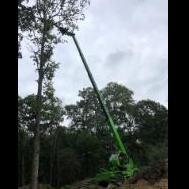I thought I would show you what testing a flip-line has to undergo to pass CE EN358. This may answer some of your questions regarding when to retire your line.
Think would my Flip-Line pass this test now?
This test was carried out on the Yale 3m Flip-line with an ISC RP203 Rope grab and fitted with an ISC KH250 Twister Karabiner. The test undertaken was to meet BS EN 358:2000.
Test 1 - Static Strength
The flip line was tested for static strength on a tensile test machine. The part of the standard requires that the adjustable element (rope grab) be loaded to 5 kN. for 3 minutes. The position of the rope grab on the flip line was marked before and after the test. The amount of slippage during this test was 15mm. The standard allows a maximum of 50mm. The rope grab was then moved to the end of the flip-line to test the strength of the end stop. The standard requires that the adjustable element (rope grab) be loaded to 15 kN. for 3 minutes. = Pass
Test 2 - Dynamic Strength Test
The weight drop test rig was used to test the dynamic performance of the rope grab on the flip line. The rope grab was positioned 1m from the karabiner (end of flip-line). The 100kg test weight was positioned level with the karabiner to allow for a 1m drop before the test weight operated the rope grab. The flip-line held the test weight although the rope sheath stripped from the wire-core. The arrest distance was 1.35 metres. The standard requires that the weight be held = pass.
Static strength & slippage - 5 kN. for 3 min. 50 mm maximum slippage
Static strength end stop - 15 kN. for 3 min.
Dynamic strength - 100 kg drop test. Must hold weight
The ISC RP203 Rope Grab is the only mechanical adjuster approved for use with the Yale Flip-Lines.
This is the same test required on soft-lanyards. Any one suppling Rope with a karabiner or Snap attached must have it approved to this standard.
To pass and approve a flip-line to CE will cost between £2000.00 to £3000.00.
BS EN 358:2000
Personal protective equipment for work positioning and prevention of falls from a height. Belts for work positioning and restraint and work positioning lanyards
When work undertaken at a height is of short duration, or for technical reasons the provision of a working platform, suitable barriers and other similar safeguards is impractical, then safe working at height can be carried out by using personal protective equipment. Equipment written to BS EN 358's specifications is designed either to secure the user safely in position or restrain them to prevent them from falling. The standard applies to belts and lanyards meant for positioning or restraint. It sets out the requirements for testing, marking and the information supplied by the manufacturer.

















